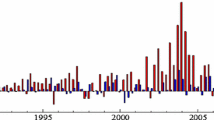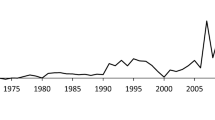Abstract
While focusing on traditional macroeconomic fundamentals, existing literature has provided little understanding of impacts of various types of capital flows on the dynamics of floating exchange rates. This paper develops a structural VAR model that takes into account macroeconomic fundamentals as well as various types of capital flows in explaining the fluctuations of the floating exchange rates of the Australian dollar, the Canadian dollar, and the U.S. dollar over 1980–2004. Our main findings are as follows. Among the traditional macroeconomic fundamentals, relative interest rate still plays a significant role in explaining exchange rate dynamics for all three currencies. Capital flows play an important role in explaining the fluctuations in the Australian dollar and the Canadian dollar, but not the U.S. dollar. In particular, portfolio investment is the most explanatory factor for the Australian dollar and the Canadian dollar. For the U.S. dollar, relative interest rate explains the most of exchange rate fluctuations, especially in the medium to the long run. The results indicate that capital market transactions do play important roles in determining exchange rates; however, it may have different implications for the reserve currencies versus the non-reserve currencies. Further research is needed.


Similar content being viewed by others
Notes
The numbers are from Chapter 7, The Foreign Exchange Market, pp248, Multinational Financial Management, 8th edition, by Alan C. Shapiro.
The objective of this paper is to investigate the impacts of different types of capital flows on the exchange rate of a currency under the floating exchange rate regime. Canada and Australia are good to use because they represent two such currencies under a floating exchange rate regime for the period studied in our paper. Another ideal feature is that they are not reserve currencies, so their exchange rates are largely explained by their own domestic and foreign activities. The U.S. dollar is included because it is the most important international currency under the dollar standard in today’s international monetary world. It is also under a pure floating exchange rate regime for the period studied. Including the three can uncover the differences, if any, of the impacts of capital flows on reserve vs. non-reserve currencies. Other major currencies are not considered either because they may have experienced major structural regime changes, such as the Euro (and the other European currencies before the introduction of the Euro), and the Japanese Yen, which went float only after the 1985 Plaza Accord; or because the currency is a less important reserve currency, such as the British pound, the inclusion of which may see redundant given that the U.S. dollar is examined.
Other capital flows are defined to be items not considered as either direct investment or portfolio investment. Some examples could be private remittances and bank loans.
Our estimation is based on trade balance data. We also estimated the model using data of the current account balance. The results are similar and are available upon request.
We also test robustness assuming \( {a_{79}} \ne 0 \) and get similar results, which are available upon request.
Trade weights are based on the average of years 1990–2000. To save space, they are not reported but are available upon request.
The trended real GDP is first computed and then converted back to trended nominal GDP using GDP deflator. Original nominal GDP data generates similar results.
The estimation is done with the Bayesian method using Monte Carlo Integration of 5,000 draws by applying the Gaussian approximation of the posterior of A 0 .
For simplicity of reading and clarity, only the sign and the degree of statistical significance of each estimated coefficient is presented. This is because the numerical value of the coefficient estimates in a VAR model is seldomly interpreted in the literature.
Degree of openness is defined as total trade as a percentage of total domestic output.
References
Backus D (1984) Empirical models of the exchange rate: separating the wheat from the chaff. Can J Econ 17(4):824–846
Baxter M, Stockman A (1989) Business cycles and the exchange rate regime: some international evidence. J Monet Econ 23(3):377–400
Branson W, Henderson D (1985) Chapter 15 The specification and influence of asset markets. Handbook Int Econ 2:749–805
Brooks R, Edison H, Kumar M, Slok T (2004) Exchange rates and capital flows. Eur Financ Manag 10(3):511–533
Campa JM, Goldberg LS (2005) Exchange rate passthrough into import prices. Rev Econ Stat 87:660–679
Clarida R, Gali J, Gertler M (1998) Monetary policy rules in practice: some international evidence. Eur Econ Rev 42:1033–1067
Dellas H, Zilberfarb B (1993) Real exchange rate volatility and international trade: a re-examination of the theory. South Econ J 59(4):641–647
Dornbusch R (1976) Expectations and exchange rate dynamics. J Polit Econ 84(6):1161–1176
Flood R, Rose A (1995) Fixing exchange rates: a virtual quest for fundamentals. J Monet Econ 36(1):3–37
Frankel J (1993) Monetary and portfolio-balance models of the determination of exchange rates. On Exchange Rates, the MIT Press
Frankle J, Rose A (1995) Empirical research on nominal exchange rates. In: Grossman G, Rogoff K (eds) Handbook of international economics. North-Holland, Amsterdam
Fry MJ, Claessens S, Burridge P, Blanchet MC (1995) Foreign direct investment, other capital flows and current account deficits: What causes what? World Bank Policy Research Working Paper No. 1527
Hallwood CP, MacDonald R (2000) International money and finance, 3rd edn. Blackwell, Oxford
Hau H, Rey H (2006) Exchange rates, equity prices, and capital flows. Rev Financ Stud 19(1):273–317
Kant C (2005) Capital mobility among advanced countries. J Policy Model 27:1067–1081
Kim S (2003) Monetary policy, foreign exchange intervention, and the exchange rate in a unifying framework. J Int Econ 60(2):355–386
Kim S (2005) Monetary policy, foreign exchange policy, and delayed overshooting. J Money, CreditBank 37(4):775–782
Kim S, Roubini N (2000) Exchange rate anomalies in the industrial countries: a solution with a structural VAR approach. J Monet Econ 45(3):561–586
Lubik T, Schorfheide F (2003) Do central banks respond to exchange rate movements? A structural investigation. John Hopkins University working paper series. http://www.econ.jhu.edu/pdf/papers/wp505lubik.pdf
MacDonald R, Taylor M (1994) The monetary model of the exchange rate: long-run relationships, short-run dynamics and how to beat a random walk. J Int Money Financ 13(3):276–290
Meese R, Rogoff, K (1982) The out-of-sample failure of empirical exchange rate models: sampling error or misspecification? International Finance Discussion Paper 204, Board of Governors of the Federal Reserve System
Meese R, Rogoff K (1983) Empirical exchange rate models of the seventies: do they fit out-of-sample? J Int Econ 14(2):3–24
Pentecost E (1991) Econometric approaches to empirical models of exchange rate determination. J Econ Surv 5(1):71–96
Shapiro A (2006) Multinational financial management, 8th edn. Wiley, USA
Sims C (1988) Bayesian skepticism on unit root econometrics. J Econ Dyn Control 12:463–474
Sims C, Uhlig H (1991) Understanding unit rooters: a helicopter tour. Econometrica 59(6):1591–1599
Siourounis G (2003) Capital flows and exchange rates: an empirical analysis, London Business School Working Paper Series
Wilamoski P, Tinkler S (1999) The trade balance effects of U.S. Foreign direct investment in Mexico. Atl Econ J 27:24–37
Taylor M (1995) The economics of exchange rates. J Econ Lit 33:13–47
Author information
Authors and Affiliations
Corresponding author
Rights and permissions
About this article
Cite this article
Sun, W., An, L. Dynamics of floating exchange rate: how important are capital flows relative to macroeconomic fundamentals?. J Econ Finan 35, 456–472 (2011). https://doi.org/10.1007/s12197-009-9103-5
Received:
Accepted:
Published:
Issue Date:
DOI: https://doi.org/10.1007/s12197-009-9103-5




